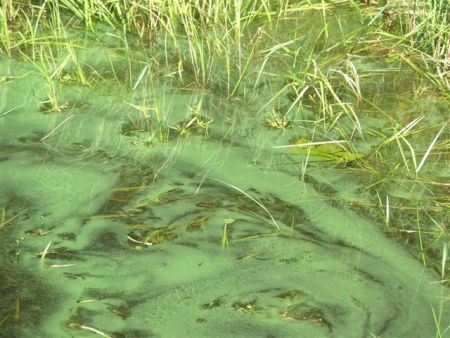HALIFAX--A proposal for a lakeside mink ranch near Carleton, Nova Scotia - roughly 20 kilometres north of Yarmouth - has resulted in some community members calling on the provincial government for a moratorium on lakeside farming. Residents are worried their lake will be condemned to the same fate as many other water-bodies in the Carleton River watershed, which have been overrun by blue-green algal blooms.
“The pollution is so bad," says Carlene MacDonald, a Carleton resident. " I’m sure if more people could be made aware of the situation they would scream 'Pollution!’ along with us.”
Tensions have been running high in Yarmouth County as residents debate the source of the blue-green algae, known as cyanobacteria, that have overtaken a number of lakes in their region. Many citizens believe their waters are being contaminated by manure, urine, offal, caustic cleaning liquids and fly control chemicals from riverside mink ranches in neighbouring Digby County. One and a half million minks are raised in Nova Scotia each year at almost 80 mink farms, according to the CBC. The majority of those mink farms are located in Digby and Yarmouth Counties.
Other potential contributing factors to the algae are faulty lakeside septic systems and run-off containing agro-industrial fertilizer.
Last October, Yarmouth County Municipal Council voted to amend a municipal land-use bylaw, increasing, from 328 to 500 feet, the required minimum set-back distance from lakes and rivers for buildings and manure storage facilities used in conjunction with fur ranches, and hog and fowl farms.
On March 30, 2010, the Nova Scotia Utility and Review Board will hear an appeal filed by the Nova Scotia Mink Breeders Association and a Yarmouth-area livestock farmer in response to the municipality’s decision to amend its set-back bylaw. The Nova Scotia Federation of Agriculture, which had initially been named among the appellants but recently withdrew its name from the appeal, has allied with the NS Mink Breeders Association to jointly present at the hearing.
The blue-green alga that is thriving in many Yarmouth County lakes is a toxin-generating microscopic plant that thrives in water containing high levels of phosphorus and nitrogen. The algae's prevalence has raised concerns over health and safety, property values, local ecologies, and the proper regulation of industry.
In July, 2009, Camp Wapomeo, a YMCA summer camp for local youth that had held its water recreations on the same lake in Yarmouth Country for eighty-one consecutive years, had to relocate their activities due to the algae and consequent safety concerns. Camp director Kathleen Whyte stated publicly that the algae’s growth is becoming more apparent each year and is inclined to attribute declining camp registration on parental concerns over health risks.
Carlene MacDonald, says the government's response has been unacceptable.
"The mink breeders choose to use 100 kilometres of river systems as their toilet and the government allows it by not responding,” says MacDonald.
“They have overlooked the pollution for so long," she says. "[I] just found out that the first complaint of mink farmers polluting the Tusket River system [of which the Carleton River is the west branch] was lodged with the Nova Scotia Federation of Agriculture and the provincial government by an area resident in 1986.” Apparently, neither body responded to the situation.
Randy Cleveland is a member of the Tusket River Environmental Protection Agency (TREPA), a group comprised of residents and concerned citizens from Carleton. TREPA has been conducting its own research and investigation into the community’s water issues.
Cleveland points to the fact that mink and fur farms are only subject to recommended guidelines for reducing environmental risk in their operations. He says Carleton needs "bylaws so the municipality would have recourse when it comes to establishing and enforcing regulations for mink and fur farms.” Presently, mink farmers in Nova Scotia are largely self-regulating entities.
In its mission statement and progress report entitled Environmental Performance of the Agricultural Sector in Nova Scotia 2009: A Report Card, the Nova Scotia Federation of Agriculture acknowledges that “manure management in areas of livestock concentration has to be improved,” and that “the mink sector, in particular, is primarily located in an area with a small cropland base, reducing alternatives to effectively manage mink manure and other wastes close to mink farms…”
The Report also states, however, that self-regulation is working. "Nova Scotia’s environmental acts and regulations support [positive on-farm environmental practices] by encouraging compliance and by establishing a culture of self-regulation, minimizing the need for a harsh regulatory approach…”
Cleveland disagrees. “The waste problem has been acknowledged and the ecological consequences are now apparent, but the culture of self-regulation is not effectively operating," he says. "The provincial acts and regulations are either too broad to be useful or not being properly enforced.”
Cleveland emphasizes that TREPA does not oppose fur farms in general, but wants to see them regulated and operated in an environmentally sound manner.
Steven is a writer and filmmaker from Harmony, NS.



